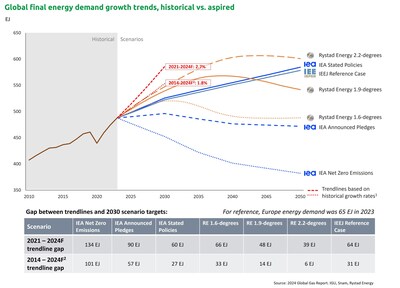The OGM Interactive Canada Edition – Summer 2024 – Read Now!
View Past IssuesAs the world continues its rapid march toward a future dominated by technology and urban growth, the demand for energy is surging at an unprecedented rate. The 2024 Global Gas Report (GGR), unveiled at the ONS Conference by the International Gas Union (IGU), Snam, and Rystad Energy, paints a stark picture of the challenges and opportunities that lie ahead. With global energy demand outpacing supply and critical underinvestment in gas and clean energy technologies, the world is on a collision course with an energy crisis that could leave 2030 climate targets in the dust.
The global gas market, a cornerstone of the world’s energy supply, remains in a precarious balance. In 2023, demand for gas increased by 1.5%, with projections indicating an even steeper rise to 2.1% by the end of 2024. Asia, with its rapidly growing economies and burgeoning industrial sectors, is driving much of this demand. North America and the Middle East, on the other hand, are emerging as leaders in gas exports, leveraging their abundant resources to meet global needs.
However, the report warns that if this trend continues without significant investment in new production, the world could face a 22% shortfall in global gas supply by 2030. Such a deficit would not only exacerbate the energy crisis but also hinder efforts to transition to cleaner energy sources. The message is clear: without a concerted push to scale up investments in natural gas and clean energy technologies, the world risks falling short of its energy needs and climate goals.
Energy demand is not just rising in the usual suspects—developing regions with growing populations and industrial sectors—but also in developed nations that are seeing a resurgence in energy consumption. Europe, despite its efforts to enhance energy efficiency, has experienced an uptick in demand, driven by a combination of factors including industrial activity and harsh winter conditions. In North America, energy demand has surpassed pre-pandemic levels, spurred by the expansion of the transport sector and the explosion of AI data centers that require vast amounts of electricity.
Asia remains the global powerhouse of energy demand, with India and China leading the charge. Their industrial sectors are expanding at breakneck speed, fueling a voracious appetite for energy that shows no signs of abating. Meanwhile, Africa’s energy demand is growing faster than most regions, propelled by rapid urban development. Yet, despite this growth, equitable access to electricity remains a significant challenge, particularly in rural areas and parts of South America. The energy divide is widening, with millions still lacking access to the basic energy services needed to lift them out of poverty.
In the face of these daunting challenges, natural gas offers a glimmer of hope. As the cleanest of the fossil fuels, it provides an immediate opportunity to reduce emissions from coal by 50% and from oil by 30% through cost-effective switching. But the benefits of natural gas extend beyond its lower carbon footprint. It is also a crucial bridge fuel, capable of supporting the transition to a more sustainable energy future while new technologies like biomethane, carbon capture and storage (CCS), and low-carbon hydrogen scale up to meet global energy demands.
Biomethane, a direct substitute for natural gas, is one such technology that holds great promise. Despite its potential, it currently accounts for only 1% of the natural gas market, with most production concentrated in North America and Europe. However, new production hubs are emerging in China and India, signaling a shift in the global energy landscape. Similarly, CCS, a technology critical to decarbonizing hard-to-abate sectors, is gaining momentum but remains underdeveloped. The same is true for low-carbon hydrogen, which has the potential to revolutionize energy systems but requires significant investment and policy support to reach its full potential.
The 2024 Global Gas Report underscores the urgent need for investment in natural gas and clean energy technologies. Without it, the world will struggle to meet its energy needs, let alone achieve its climate goals. IGU President, Mme Li Yalan, emphasizes the importance of finding a realistic balance between growing energy demand and long-term sustainability. “We must look for a realistic way to balance these trends with long-term sustainability goals, such as building a diversified energy system and comprehensive approaches to tackle climate change,” she states.
Snam CEO, Stefano Venier, echoes this sentiment, highlighting the complexity of the energy transition. “The energy transition represents a unique challenge for mankind. A journey that will not be linear, marked by great aspirations and many hurdles, from geopolitical tensions to technology disruptions and unforeseeable global economic developments,” he says. Venier stresses the critical role of natural gas and related infrastructure in ensuring the resilience of the global energy system, while new green and low-carbon molecules will be essential to achieving a just and technologically neutral transition.
The path to a sustainable energy future is fraught with challenges, but it is also filled with opportunities. As Rystad Energy CEO, Jarand Rystad, notes, “Natural gas, now 30% of the fossil fuel mix, is cheaper and cleaner than oil and coal, with emissions significantly lower than both. As global LNG access expands, natural gas is on track to surpass coal by 2030 and oil by 2050.”

The 2024 Global Gas Report serves as a clarion call to the global energy community. The choices made today will determine whether the world can meet its energy needs and climate goals tomorrow. The stakes have never been higher, and the time for action is now.
Sources: International Gas Union (IGU)
Did you enjoy this article?